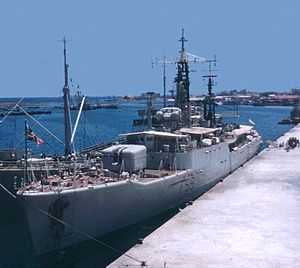HMS Chichester (F59)
 HMS Chichester at Famagusta, 1960 | |
| Career (UK) | |
|---|---|
| Name: | HMS Chichester (F59) |
| Ordered: | 28 June 1951 |
| Builder: | Fairfields |
| Laid down: | 26 June 1953 |
| Launched: | 21 April 1955 |
| Commissioned: | 16 May 1958 |
| Fate: | Sold for breaking 17 March 1981 |
| General characteristics | |
| Class and type: | Salisbury-class frigate |
| Displacement: | 2,170 tons standard 2,400 tons full load |
| Length: | 340 ft (100 m) o/a |
| Beam: | 40 ft (12 m) |
| Draught: | 15 ft 6 in (4.72 m) |
| Propulsion: | 8 × ASR1 diesels, 12,400 shp, 2 shafts |
| Speed: | 24 kn (44 km/h) |
| Range: | 7,500 nmi (13,900 km) at 16 kn (30 km/h) |
| Complement: | 235 |
| Sensors and processing systems: | Type 960 air search radar, later Type 965 AKE-2 Type 293Q target indication radar, later Type 993n Type 982 aircraft direction radar, laterType 986 Type 277Q height finding radar, later Type 278 Type 974 navigation radarlater Type 978 Type 285 fire control radar on director Mark 6M Type 262 fire control on STAAG mount Type 1010 Cossor Mark 10 IFF Type 174 search sonar Type 170 attack sonar |
| Armament: | 1 × twin 4.5 in gun Mark 6 1 × twin 40 mm Bofors gun STAAG Mark 2, later 1 × twin 40 mm Bofors gun Mk.5 1 × Squid A/S mortar |
HMS Chichester (F59) was a Salisbury-class or Type 61 aircraft direction frigate of the British Royal Navy.
Service
Chichester was first commissioned in 1958 and in that year rescued crew of the coaster CONCHA off Milford Haven before ship sank.[1] The commission took her through the Mediterranean to the Far East returning via South Africa and South America.[2]
In 1968 she deployed for Fishery Protection duties and was accused by the Soviet Union (USSR) of spying on Soviet naval exercises.[3]
Towards the end of her career, in 1971 the type 61 frigate was refitted as a Hong Kong guard ship, to replace an ageing Whitby Type 12 frigate, due in part to her good range conferred by her diesel machinery. Her radar fit was reduced to radar 978, 293M and the 275, Mk 6 director for the twin 4.5 and a more suitable light arms for patrol off Hong Kong of a 2 single 20mm guns and a 1 X 40mm Bofors.[4]
The election of the Labour Government in 1974 saw a futhur reduction of naval forces, East of Suez with the frigate being replaced by Ton class minesweepers, as the largest vessels maintaining a presence for protection of British interests.
Following decommissioning Chichester arrived for scrapping at Queenborough on 17 March 1981.[5]
Commanding Officers
| From | To | Captain |
|---|---|---|
| 1958 | 1959 | Commander I D Butt RN |
| 1960 | 1964 | Commander G A Rowan-Thompson RN |
| 1964 | 1966 | Commander H B Parker RN |
| 1966 | 1968 | |
References
- ↑ http://www.naval-history.net/xGM-Ops-Events1951-60.htm
- ↑ http://www.rjerrard.co.uk/royalnavy/chicrn/chicrn.htm
- ↑ http://www.naval-history.net/xGM-Ops-Events1961-70.htm
- ↑ Marriot, Leo. Royal Navy Frigates 1945-1983. Ist ed Shepperton UK (1983). Ian Allen, p 50-1
- ↑ http://clydesite.co.uk/clydebuilt/viewship.asp?id=1076
Publications
- Colledge, J. J.; Warlow, Ben (2006) [1969]. Ships of the Royal Navy: The Complete Record of all Fighting Ships of the Royal Navy (Rev. ed.). London: Chatham Publishing. ISBN 978-1-86176-281-8. OCLC 67375475.
- Marriot, Leo (1983). Royal Navy Frigates 1945–1983. Shepperton, UK: Ian Allen. ISBN 0-7110-1322-5.
| ||||||||||||||||||